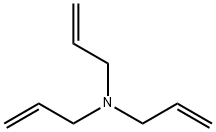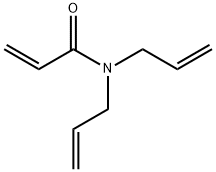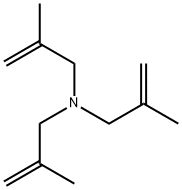Triallylamine
Synonym(s):TAA
- CAS NO.:102-70-5
- Empirical Formula: C9H15N
- Molecular Weight: 137.22
- MDL number: MFCD00026093
- EINECS: 203-048-2
- SAFETY DATA SHEET (SDS)
- Update Date: 2025-09-25 17:15:13

What is Triallylamine?
Chemical properties
dark brown liquid
Chemical properties
Triallylamine is a flammble liquid. Triallylamine can be detected at 0.5 ppm and is severely irritating at 75 ppm.
The Uses of Triallylamine
Triallylamine is used in organic synthesis.Triallylamine has been proposed as a catalyst for the production of polyesters and as an initiator for the polymerization of butadiene.
The Uses of Triallylamine
- Triallylamine (TAA) reacts with primary aromatic amines in the presence of a ruthenium catalyst to form 2-ethyl-3-methylquinolines.
- TAA undergoes hydrozirconation followed by transmetalation with germanium tetrachloride to form 1-aza-5-germa-5-chlorobicyclo[3.3.3]undecane. This compound can react with Grignard or lithium reagents to form the corresponding 5-organo compounds.
- The cycloaddition of TAA to fluorinated 1,3,4-oxadiazoles affords octahydro-2,7-methanofuro[3,2-c]pyridines.
Production Methods
Triallylamine is manufactured using allyl chloride and ammonia under heat and pressure. It is used as a solvent and in organic syntheses.
What are the applications of Application
Triallylamine (TAA) reacts with primary aromatic amines in the presence of a ruthenium catalyst to form 2-ethyl-3-methylquinolines.
TAA undergoes hydrozirconation followed by transmetalation with germanium tetrachloride to form 1-aza-5-germa-5-chlorobicyclo[3.3.3]undecane. This compound can react with Grignard or lithium reagents to form the corresponding 5-organo compounds.
The cycloaddition of TAA to fluorinated 1,3,4-oxadiazoles affords octahydro-2,7-methanofuro[3,2-c]pyridines.
Definition
ChEBI: Triallylamine is a tertiary amino compound.
General Description
A colorless liquid with a fishlike odor. Density 0.800 g / cm3 and insoluble in water. Hence floats on water. Flash point 103°F. Vapors heavier than air. May irritate skin and eyes. Used to make other chemicals.
Air & Water Reactions
Flammable. Insoluble in water.
Reactivity Profile
Triallylamine is a strong reducing agent that reacts violently with oxidizing agents. Corrosive towards Al and Zn [Handling Chemicals Safely 1980 p. 912] . Neutralizes acids in exothermic reactions to form salts plus water. May be incompatible with isocyanates, halogenated organics, peroxides, phenols (acidic), epoxides, anhydrides, and acid halides. Flammable gaseous hydrogen may be generated in combination with strong reducing agents, such as hydrides.
Health Hazard
May cause toxic effects if inhaled or ingested/swallowed. Contact with substance may cause severe burns to skin and eyes. Fire will produce irritating, corrosive and/or toxic gases. Vapors may cause dizziness or suffocation. Runoff from fire control or dilution water may cause pollution.
Fire Hazard
Flammable/combustible material. May be ignited by heat, sparks or flames. Vapors may form explosive mixtures with air. Vapors may travel to source of ignition and flash back. Most vapors are heavier than air. They will spread along ground and collect in low or confined areas (sewers, basements, tanks). Vapor explosion hazard indoors, outdoors or in sewers. Runoff to sewer may create fire or explosion hazard. Containers may explode when heated. Many liquids are lighter than water.
Safety Profile
Poison by skin contact and intraperitoneal routes. Moderately toxic by ingestion and inhalation. An eye and severe skin irritant. Human systemic effects by inhalation: structural or functional changes in trachea or bronchi. Flammable liquid when exposed to heat, flame or oxidlzers. To fight fire, use foam, alcohol foam, fog. When heated to decomposition it emits toxic fumes of NOx. See also AMINES and ALLYL COMPOUNDS.
Properties of Triallylamine
| Melting point: | -70°C |
| Boiling point: | 150-151 °C (lit.) |
| Density | 0.79 g/mL at 25 °C (lit.) |
| vapor density | 4.73 (vs air) |
| vapor pressure | 90 mm Hg ( 80 °C) |
| refractive index | n |
| Flash point: | 87 °F |
| storage temp. | 2-8°C |
| form | clear liquid |
| pka | pK1:8.31(+1) (25°C) |
| color | Colorless to Yellow to Orange |
| Water Solubility | 250 g/100 mL |
| Stability: | Stable. Flammable. Incompatible with strong oxidizing agents. |
| CAS DataBase Reference | 102-70-5(CAS DataBase Reference) |
| NIST Chemistry Reference | 2-Propen-1-amine, N,N-di-2-propenyl-(102-70-5) |
| EPA Substance Registry System | Triallylamine (102-70-5) |
Safety information for Triallylamine
| Signal word | Danger |
| Pictogram(s) |
 Flame Flammables GHS02  Corrosion Corrosives GHS05  Skull and Crossbones Acute Toxicity GHS06 |
| GHS Hazard Statements |
H226:Flammable liquids H314:Skin corrosion/irritation H331:Acute toxicity,inhalation |
| Precautionary Statement Codes |
P210:Keep away from heat/sparks/open flames/hot surfaces. — No smoking. P280:Wear protective gloves/protective clothing/eye protection/face protection. P301+P312:IF SWALLOWED: call a POISON CENTER or doctor/physician IF you feel unwell. P303+P361+P353:IF ON SKIN (or hair): Remove/Take off Immediately all contaminated clothing. Rinse SKIN with water/shower. P305+P351+P338:IF IN EYES: Rinse cautiously with water for several minutes. Remove contact lenses, if present and easy to do. Continuerinsing. |
Computed Descriptors for Triallylamine
| InChIKey | VPYJNCGUESNPMV-UHFFFAOYSA-N |
New Products
4,4-Difluoropiperidine hydrochloride tert-butyl 9-methoxy-3-azaspiro[5.5]undecane-3-carboxylate Indole Methyl Resin N-Isopropylurea N,N-Dicyclohexylcarbodiimide(DCC) MELDRUMS ACID 5-METHYLISOXAZOLE-4-CARBOXYLIC ACID Magnessium Bis glycinate Zinc ascorbate 1-bromo-2-butyne 2-acetamidophenol 9(10H)-anthracenone Erythrosin B, 4-Piperidinopiperidine 2-((4-morpholinophenylamino) (methylthio) methylene) malononitrile 2,4-dihydroxybenzaldehyde 3-(4-morpholinophenylamino)-5-amino-1H-pyrazole-4-carbonitrile Methyl 2-methylquinoline-6-carboxylate 2,6-dichloro-4-nitropyridine 4-Bromo-2-chlorobenzonitrile 2-(benzylamino)acetic acid hydrochloride 4-(tert-Butoxycarbonylamino)but- 2-ynoic acid 3,4-dihydro-2H-benzo[b][1,4]dioxepine 1-Phenyl-1-cycloprppanecarboxylicacidRelated products of tetrahydrofuran








You may like
-
 Triallylamine CAS 102-70-5View Details
Triallylamine CAS 102-70-5View Details
102-70-5 -
 Triallylamine 98% (GC) CAS 102-70-5View Details
Triallylamine 98% (GC) CAS 102-70-5View Details
102-70-5 -
 Triallylamine 95% CAS 102-70-5View Details
Triallylamine 95% CAS 102-70-5View Details
102-70-5 -
 Triallylamine CAS 102-70-5View Details
Triallylamine CAS 102-70-5View Details
102-70-5 -
 3-(4-amino-1-oxoisoindolin-2-yl)-1-methylpiperidine-2,6-dione 98%View Details
3-(4-amino-1-oxoisoindolin-2-yl)-1-methylpiperidine-2,6-dione 98%View Details -
 20677-73-0 (2,2-diethoxyethyl)methylamine 98%View Details
20677-73-0 (2,2-diethoxyethyl)methylamine 98%View Details
20677-73-0 -
 3-(4-(hydroxyamino)-1-oxoisoindolin-2-yl)piperidine-2,6-dione 98%View Details
3-(4-(hydroxyamino)-1-oxoisoindolin-2-yl)piperidine-2,6-dione 98%View Details -
 57381-49-4 2-bromo-4-chlorobenzonitrile 98%View Details
57381-49-4 2-bromo-4-chlorobenzonitrile 98%View Details
57381-49-4
